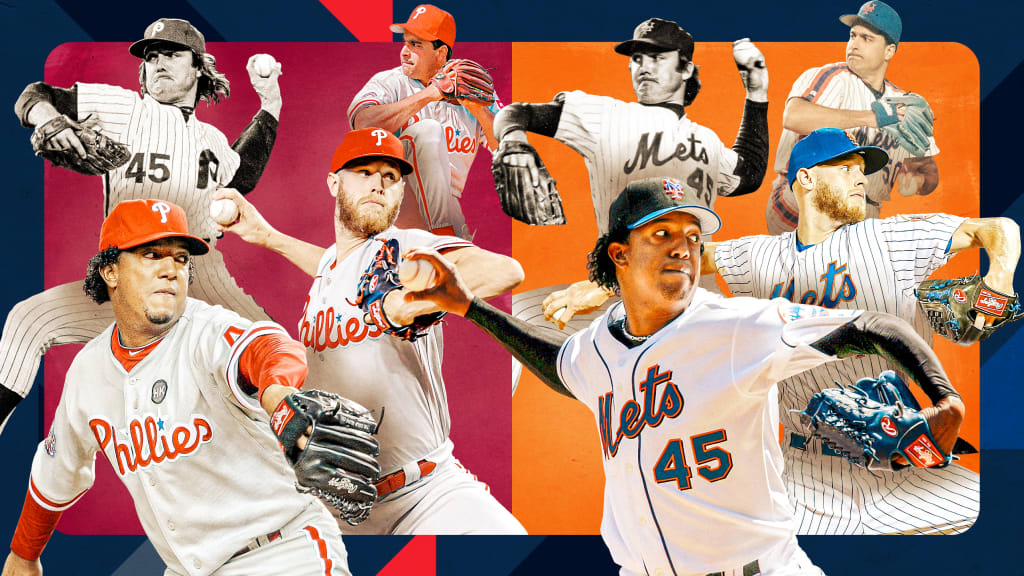
The Mets have been around for 62 years. The Phillies date all the way back to 1883. As the two clubs meet in the postseason for the first time in Game 1 of the National League Division Series on Saturday, their rich histories are in the October spotlight.
The two franchises are rivals in the NL East division and have faced off in some classic games over the years. Some of the greatest players in baseball history suited up for the Mets or Phillies during their careers. And some even played for both.
Here¡¯s a look at the 10 best players to don the uniform of the Mets and the Phillies (based on overall player record and contributions to both clubs):
1. Pedro Martinez (Mets from 2005-08, Phillies in 2009)
About six weeks after helping the Red Sox win their first World Series title in 86 years, Martinez joined the Mets on a four-year, $53 million contract. While he wasn¡¯t the historically dominant pitcher who won three Cy Young Awards from 1997-2003, the future Hall of Famer posted a 3.88 ERA over his four-year stint with New York. Injuries took their toll, however -- he made only 25 starts from 2007-08.
At age 37, Martinez signed a midseason contract with the Phillies in 2009. Over nine starts, he had a 3.63 ERA and helped Philadelphia make a second consecutive World Series appearance. In Game 2 of the National League Championship Series against the Dodgers, he recaptured his old form, throwing seven scoreless innings in a 2-1 Phillies loss. In the World Series, he started Game 2 and Game 6, combining to give up seven runs in 10 innings as Philadelphia lost in six games to the Yankees.
2. Richie Ashburn (Phillies from 1948-59, Mets in 1962)
Ashburn is considered one of the best to ever play for the Phillies. The Hall of Famer was a four-time All-Star and a two-time batting champion with the Phils while cementing his status as one of the best defensive center fielders in the game. He led either the NL or the Majors in hits three times (1951, ¡¯53 and ¡¯58), led MLB in triples twice (1950 and ¡¯58) and led the league or MLB in on-base percentage four times (1954, ¡¯55, ¡¯58 and ¡¯60).
Following a pair of seasons with the Cubs, Ashburn¡¯s lone season with the Mets came in the franchise¡¯s first year and his final year in the Majors -- in 1962, he had an All-Star campaign in which he hit .306 in 135 games for New York. Overall, he batted .308 over his 15-year career.
3. Billy Wagner (Phillies from 2004-05, Mets from 2006-09)
Though he spent the first nine seasons of his Major League career with the Astros, Wagner spent the next six with the Phillies and Mets. Following the 2003 season, Houston traded the left-hander to Philadelphia. In his two seasons with the Phillies, Wagner was tremendous, posting a 1.86 ERA with 59 saves. A free agent following the ¡¯05 campaign, he signed a four-year, $43 million contract with the rival Mets.
Despite heading into his late-30s with New York, Wagner preserved his status as one of the game¡¯s elite closers. He had a 2.37 ERA and racked up 101 saves from 2006-09, when he was sent to the Red Sox in a midseason trade. Overall, Wagner¡¯s 422 career saves are two shy of the record for left-handers. He was also a seven-time All-Star, with three of those selections coming during his time with the Phillies (2005) and Mets (2007-08).
4. Lenny Dykstra (Mets from 1985-89, Phillies from 1990-96)
Dykstra was a hard-nosed spark plug at the top of New York¡¯s lineup during a very successful era for the franchise. In 1986, he batted .295 with 31 steals to help the Mets reach the postseason. He then hit .300 with three home runs in the playoffs, including a game-winner in Game 3 of the NLCS against the Astros. The Mets beat the Red Sox in a famous seven-game World Series.
Dykstra helped drive the Mets to the postseason again in 1988, but New York lost to the Dodgers in the NLCS. With Dykstra being due for free agency following the 1990 season, the Mets traded him to Philadelphia in June of ¡¯89. In ¡¯90, he earned the first of three career All-Star selections. The best season of his career came in ¡¯93, when he led the league in hits (194) and walks (129) while leading MLB with 143 runs scored. He finished second in NL MVP voting and helped fuel a run to the World Series, which the Phils lost in six games to the Blue Jays. Dykstra batted .348 with four home runs and four steals that postseason.
5. Tug McGraw (Mets from 1965-74, Phillies from 1975-84)
McGraw, a screwball savant, spent his entire Major League career in either a Phillies or a Mets uniform, pitching nine seasons for New York and 10 for Philadelphia. The left-hander was a star for the ¡°Miracle Mets¡± during their improbable World Series run in 1969, posting a 2.24 ERA over 100 1/3 innings during the regular season before throwing three scoreless innings in the NLCS against the Braves.
From 1971-72, McGraw had a 1.70 ERA over 217 innings, and in ¡¯73, he was excellent for the Mets in the playoffs -- he appeared in eight postseason games that October and posted a 1.93 ERA, though New York lost in the World Series to the A¡¯s. Following the ¡¯74 season, the Mets traded McGraw to the Phillies. He was voted an All-Star in ¡¯75, and in ¡¯80, he finished fifth in NL Cy Young Award voting. McGraw then appeared in four games against the Royals in that fall¡¯s World Series, giving up one run over 7 2/3 innings. He got the final out in Game 6 with a strikeout of Willie Wilson to clinch the Phillies¡¯ first World Series title.
6. Jerry Koosman (Mets from 1967-78, Phillies from 1984-85)
Like McGraw, Koosman had a 19-year MLB career that began with the Mets. In each of his first two full seasons, the left-hander was an All-Star, pitching to a 2.18 ERA over 67 appearances (66 starts) from 1968-69. He was another key cog in the machinery of the surprising ¡¯69 Mets squad, which beat the Orioles to win the franchise¡¯s first World Series championship. He started and won two games in the Series, finishing with a 2.04 ERA. He was strong again in the ¡¯73 postseason, posting a 2.55 ERA over three starts, including a complete game victory in Game 3 of the NLCS against the Reds.
Koosman spent five more seasons with the Mets, finishing runner-up in NL Cy Young Award voting in 1976. Following the ¡¯78 campaign, New York traded him to the Twins. Koosman pitched for Minnesota from 1979-81, when he was dealt to the White Sox. Chicago traded him to Philadelphia prior to the ¡¯84 season. His two years with the Phillies were the final two of his career -- he appeared in 55 games, posting a 3.67 ERA.
7. Bobby Abreu (Phillies from 1998-2006, Mets in 2014)
Abreu is one of the more underrated players of his era. The best stretch of his 18-year MLB career came during his nine seasons with the Phillies. Over that span he batted .303 with 195 home runs and 254 stolen bases. He was named an All-Star twice (2004-05), received NL MVP votes five times and won a Gold Glove Award in 2005 for his defensive excellence in right field. He was extremely durable, playing in no fewer than 151 games in a season during that period.
Following stints with the Yankees, Angels and Dodgers, Abreu signed with the Mets for his final season in 2014. In his age-40 campaign, he appeared in 78 games for New York, batting .248 with nine doubles and a home run.
8. Zack Wheeler (Mets from 2013-19, Phillies from 2020-present)
Wheeler was drafted sixth overall by the Giants in 2009, and San Francisco traded him to the Mets for Carlos Beltr¨¢n in 2011. The right-hander made his MLB debut in ¡¯13, and it was successful -- he made 17 starts with a 3.42 ERA. The next season, he posted a 3.54 ERA over 32 starts. But then he had to undergo Tommy John surgery on his elbow, and due to setbacks during his rehab, he missed both the ¡¯15 and ¡¯16 campaigns.
Finally returning to the mound in 2017, Wheeler struggled to a 5.21 ERA over 17 starts before being shut down due to injury. Over his final two seasons with the Mets, Wheeler made 60 starts with a 3.65 ERA. He signed with the rival Phillies prior to the pandemic-shortened 2020 campaign, and he¡¯s been fantastic for the Phils since. In ¡¯21, he finished runner-up in NL Cy Young Award voting, and the following year, he helped Philadelphia reach the World Series. In ¡¯23, he finished sixth in Cy Young Award balloting and won his first Gold Glove Award.
9. Sid Fernandez (Mets from 1984-93, Phillies from 1995-96)
The Mets acquired Fernandez in a trade with the Dodgers prior to the 1984 season, and he would spend 10 seasons with New York and become a key contributor to the ¡¯86 World Series championship team. Over his decade with the Mets, the left-hander produced a 3.14 ERA over 255 appearances (250 starts). In the ¡¯86 World Series against the Red Sox, he yielded one run over 6 2/3 relief innings, striking out 10 and walking only one.
Fernandez signed with the Orioles as a free agent after the 1993 season, but he struggled to a 5.59 ERA before Baltimore released him on July 10, 1995. Three days later, he signed with the Phillies, and over two seasons with Philadelphia, he found his old form, pitching to a 3.38 ERA in 22 starts. Fernandez signed with the Astros following the ¡¯96 campaign, but after making one start -- the 300th of his career -- an elbow injury ended his career.
10. Gregg Jefferies (Mets from 1987-91, Phillies from 1995-98)
The Mets drafted Jefferies 20th overall in the 1985 Draft, and he was in the Majors by ¡¯87. His first full season was in ¡¯89, and he held his own, batting .258 with 12 home runs and 21 steals. The following year, he showed marked improvement, hitting .283 with a league-best 40 doubles. Jefferies was traded to the Royals after the ¡¯91 campaign in a deal that sent former Cy Young Award winner Bret Saberhagen to New York.
Jefferies was only with Kansas City for one season before being traded to the Cardinals. With St. Louis, he had his two best seasons, earning an All-Star selection in each. That performance landed him a four-year, $20 million contract with the Phillies, who were not going to re-sign first baseman John Kruk. While he wouldn¡¯t replicate the success he enjoyed in St. Louis, Jefferies hit .287 with a .340 on-base percentage for Philadelphia from 1995-98. The Phils traded him to the Angels during the ¡¯98 season, and he finished his career with the Tigers, for whom he played in ¡¯99 and 2000.
